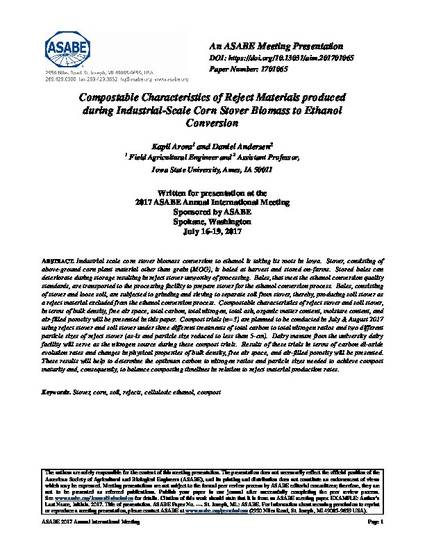
Industrial scale corn stover biomass conversion to ethanol is taking its roots in Iowa. Stover, consisting of above-ground corn plant material other than grain (MOG), is baled at harvest and stored on-farms. Stored bales can deteriorate during storage resulting in reject stover unworthy of processing. Bales, that meet the ethanol conversion quality standards, are transported to the processing facility to prepare stover for the ethanol conversion process. Bales, consisting of stover and loose soil, are subjected to grinding and sieving to separate soil from stover, thereby, producing soil stover as a reject material excluded from the ethanol conversion process. Compostable characteristics of reject stover and soil stover, in terms of bulk density, free air space, total carbon, total nitrogen, total ash, organic matter content, moisture content, and air-filled porosity will be presented in this paper. Compost trials (n=3) are planned to be conducted in July & August 2017 using reject stover and soil stover under three different treatments of total carbon to total nitrogen ratios and two different particle sizes of reject stover (as-is and particle size reduced to less than 5-cm). Dairy manure from the university dairy facility will serve as the nitrogen source during these compost trials. Results of these trials in terms of carbon di-oxide evolution rates and changes in physical properties of bulk density, free air space, and air-filled porosity will be presented. These results will help to determine the optimum carbon to nitrogen ratios and particle sizes needed to achieve compost maturity and, consequently, to balance composting timelines in relation to reject material production rates.
Available at: http://works.bepress.com/daniel_andersen/49/

This proceeding is from 2017 ASABE Annual International Meeting, Paper No. 1701065, pages 1-2 (doi: 10.13031/aim.201701065). St. Joseph, Mich.: ASABE.